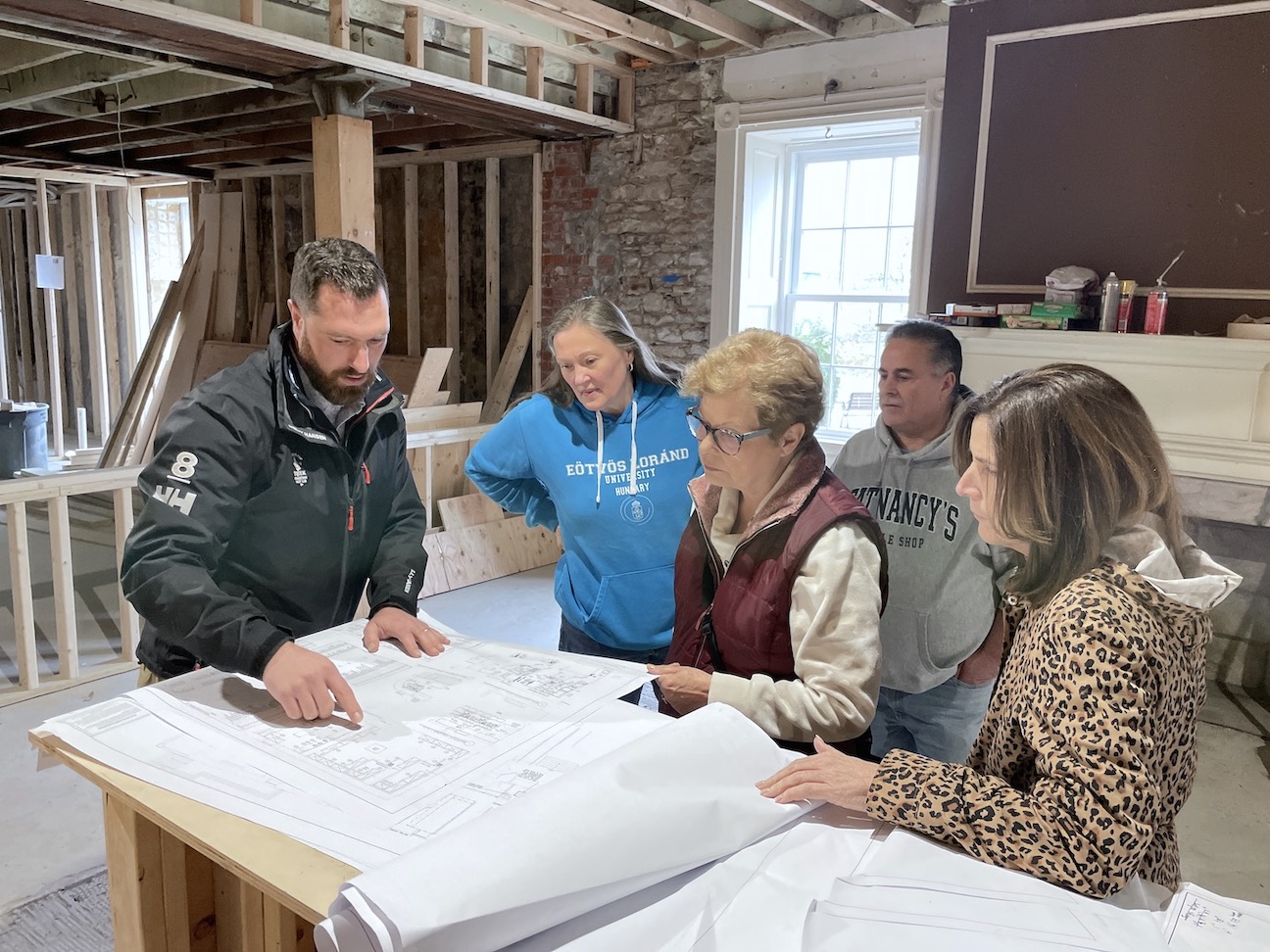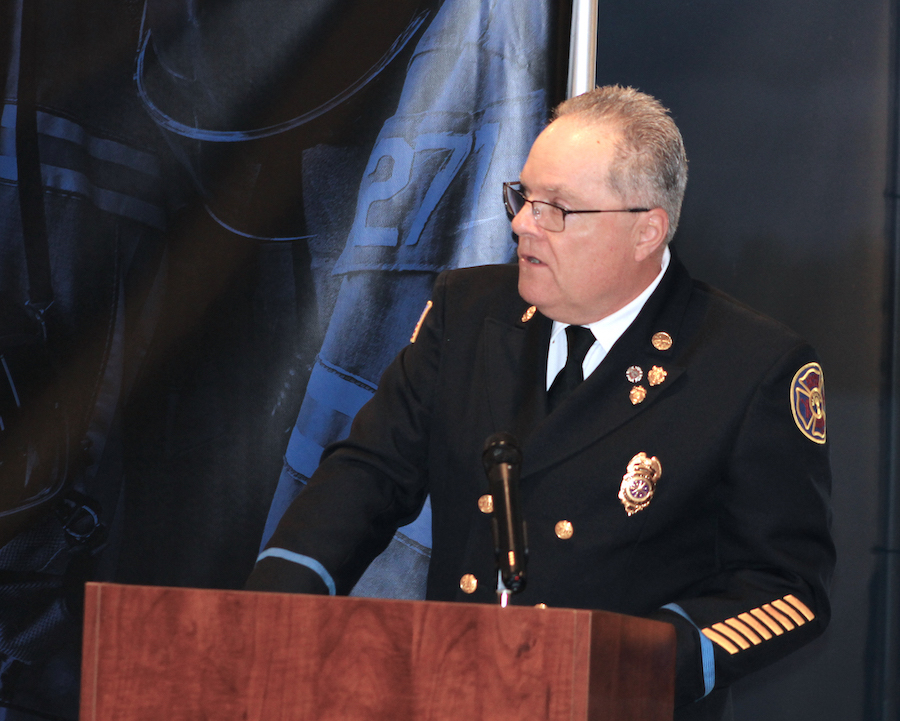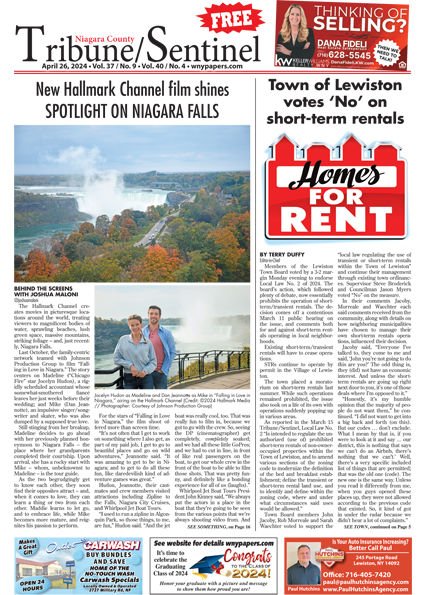Featured News - Current News - Archived News - News Categories
By Michael DePietro
Interim Tribune Editor
A proposed residential subdivision on Shawnee Road has neighborhood residents concerned about dangerous road conditions and flooding.
On Monday, the Town of Wheatfield held a public hearing on a subdivision application from DJC Land Inc., regarding a 53-acre parcel of land located between Shawnee Road and Townline Road, just north of Slusaric Road. Referred to as “Wheatfield Crossing,” the proposal seeks to subdivide the parcel, which has been traditionally farmland, into 73 single-family residential lots. The board approved a negative environmental declaration for the project during its July 6 meeting, per SEQR.
At the meeting’s onset, Tim Zuber of Wendel Engineering, the town’s engineering firm, and Ken Zollitsch of the engineering firm GPI, were on hand to provide an overview and field questions about the project.
A number of the residents who spoke on the project were concerned with how it could potentially impact traffic on Shawnee Road, an area which they say is dangerous already.
Jim Benner, who lives in the nearby Briars subdevelopment, was the first to speak. He said that while he was in favor of the development because it brings more economic opportunities to the town, he and other residents of the Briars are concerned, “The traffic on Shawnee (Road) tends to be quite busy and quite fast on an everyday basis, especially during rush hour. People are starting to get a little bit concerned. There were some accidents over the last several years. A fatality did occur near this development.”
Benner asked what plans the town and the DOT had to deal with the issue. Wheatfield Supervisor Don MacSwan said officials are looking to lower the area speed limit.
“You know, we deal with DOT quite often. They felt that, (as a) New York state highway, it can handle the traffic. And it can. I mean, it’s a large highway and there are times when you have much more traffic. One of the options would be, especially when you start having intersections together ... is to reduce the speed limit of that area. So, that’s typically what they do because sometimes (additional traffic signals) create more accidents. So that’s one of the things that should apply. A possibly reduced speed from 55 to 40 mph,” MacSwan said.
Elsewhere, Zollitsch said, “I’m sure the developer would be more than interested in seeing that speed limit lowered. I mean, obviously with the new community and neighbors coming in, we want it to be safe, as well.”
Benner also asked if the town could request dedicated turning lanes into the local developments. MacSwan said, “It’s something we will consider.”
Julie Otto echoed Brenner’s concerns saying the conditions at the top of the hill are particularly bad in the winter.
“That top of the hill ... That is a recipe for disaster,” Otto said. “People are flying through there. It’s blind and, in the winter, it is unbelievable. You cannot keep it clean there, No. 1, No. 2, the state actually even comes in with a big payloader and cleans out the (snow) drifts and, no matter how much salt they put on it, it just seems to glaze there. ...
“I understand you’ve done a lot of work, but as somebody that travels through there constantly, it is a hazard. ... I’m not trying to be a pain. I’m trying to warn you about something that could potentially be devastating.”
Jessica Coram, who recently moved onto Shawnee Road, said that, having experienced the road conditions both as someone unfamiliar with the area and as a regular user, the dangers cannot be overstated.
“We know that there have been pedestrian fatalities on Shawnee Road, and as a Shawnee Road resident, I can also echo all the comments about thinking ‘I’m going to get hit in the rear end if I try to turn left into my residence. I’ve only lived there for a little over almost a year now … I was one of the people that (caused a backup) on Shawnee Road (laughs.) Now, I experienced it as a resident.”
Coram added that she believes that the state has a responsibility to make the road safer and more accessible to pedestrians and bicyclists.
“The state needs to be more responsive to our town’s concerns about safety and they need to adhere to their own regulations and laws, like the Complete Streets Bill, which says that roads should not just be a thoroughfare for cars, but (also) bikes and pedestrians. I don’t want to see any more fatalities happen here in Wheatfield. I don’t want to become like the Boulevard where it seems like they’re dealing with a pedestrian incident every year,” Coram said.
When questioned if there were any plans for sidewalks for the Wheatfield Crossing development, Zuber said that the town does not have sidewalks on the road as part of their guidelines.
Donald Fickelsherer offered criticism from the perspective of local farmers. Firstly, he noted the difficulty in moving farm equipment along the road.
“You keep making these roads narrower and narrower. We can’t get down and we can’t do more than 10-15 miles an hour and you get all these people pissed off at you,” Fickelsherer said.
He then spoke about ongoing issues with drainage and flooding already in the area, which he says have begun to make his land unfarmable.
Earlier in the meeting, Zollitsch said the project is to have “two significantly sized stormwater ponds,” which he says will “actually cut down the amount of drought run-off that’s coming from this property towards the adjacent properties on Townline Road … ultimately reducing the amount of drainage that’s coming off this site as it currently stands today.”
Zollitsch also said a sewer capacity study performed at the area identified “deficiencies” with the pump station and said that the developer would be paying to have the substation replaced.
Fickelsherer said he believes the proposed retention ponds won’t be enough and that he expects further damage to local farmland.
“Townline Road, for 50 years. … Every year, 150-200 feet of that fills up with water. And that’s coming off of Shawnee Road, my farm and everything,” he said. “Now, you put something there to block the water, it’s going to force it back. And this is what pisses me off when you do these developments: They never ask a farmer. Every time we go to a meeting, ‘Agricultural! Agricultural! We want to keep you here!’ Well, I hope you get your houses and then you don’t know what to do here. (If) this place floods my farm, I will take a lawyer and I will rip you up all a new one.”
MacSwan inquired as to what capacity the proposed stormwater frontage would have. Zuber explained New York state requires stormwater frontage to handle 100-year floods. According to the NY State Stormwater Management Design Manual, “a 100-year flood typically occurs after between five and eight inches of rainfall in a 24-hour period (i.e., the 100-year storm). However, snow melt combined with precipitation can also lead to a 100-year flood.”
“Well, I’ll tell you what. We’ve had the 100-year storms ... Half that farm drains through my fields. Once you put concrete and blacktop, there’s 27,000 gallons of water in an inch, on an acre that’s got no place to go. ... You put them in these retention ponds, and they seep underneath, 10-15 acres of my ground is going to be worthless. And don’t someone tell me ‘Oh no, a pond won’t do that.’ It does. I’ve had it down in Spice creek where I got ground in there that used to be the best ground in the county. You can’t farm it (now) because the soil is full of water.
Fickelsherer also asked why developments couldn’t be taking place elsewhere in the town.
“I mean, you have (the whole) town. What (about) all the ground down towards the boulevard that hasn’t been built? Get them built first before you come this way. I’m not against selling ground, but if you want us to farm … this is going to cause a problem on Townline Road with water and I don’t care what you say. You’ve got to prove something different because it’s been that way for 50 years and you’ve got to get Pendleton to open up the creek. And they won’t do it because they don’t want Wheatfield’s water. But you’ve got Shawnee Road, Slusaric Road, Townline – probably 300 acres of water coming in there and no place to go.”
Residents weren’t the only ones to express their concerns about the project. Councilman Randy Retzlaff asked why town-owned roads would be used for construction versus nearby State-owned roads, noting the damage to roads construction vehicles would likely cause.
“You say you’re gonna start from the east … Why would you start there and ruin our road? Why wouldn’t you come right up the state highway with all your trucks?” Retzlaff asked.
Zollitsch replied, “In terms of phasing, all the storm drainage and all the sanitary sewers naturally flow to the east. So, we really can’t start on the west side without putting all the infrastructure in for the east side just because everything’s fed by gravity.”
Retzlaff added, “I would like to see you use the state road to get a hall road in there. You’re gonna bond the road and then the bonds released 10 years from now, the road’s shot and we gotta fix the road.”
Highway Superintendent Paul Siegman shared similar fears about road damage, saying, “When they’re building subdivisions, and they destroy our other roads in the process, that just adds more to my costs. We have a hard time getting all our roads paved the way we want to as it is.”
Zollitsch said the issues would be considered and discussed with the engineers as the project moves forward.
A second public hearing was also held regarding the installation of new, 10-inch waterlines, along Shawnee Road. The project would replace nearly 1,600 linear feet of 8-inch waterline currently installed in the area, which MacSwan noted was in “total deterioration.” Per the agenda, the maximum cost of the project is said to be $910,000.
In response to a question about the location of the construction, Zuber explained that replacement is going to go from where the southeast corner of Forest Parkway meets Shawnee Road (near Matty’s Food Mart) it’ll continue south to the end of Old Shawnee Road.
No other public comments or concerns were voiced.





























